NCC: Land Lines – Getting bogged down
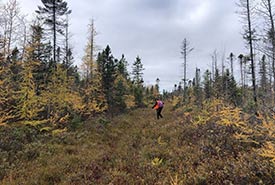
Megan Quinn leading the field team through the Alfred Bog (Photo by NCC)
It’s easy for me to get to most of the Nature Conservancy of Canada’s (NCC) properties in eastern Ontario. I load up the driving directions on my phone, and the GPS takes me right to the trailhead. I might have a strenuous hike when I get there, but 90 per cent of the time getting there is simple because the property is right by a road.
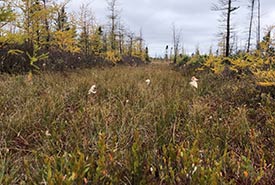
The Alfred Bog, ON (Photo by NCC)
Then there’s Alfred Bog!
In 2021, NCC purchased a parcel of land in the middle of the Alfred Bog – the Horlings-Gleeson property. Located an hour east of Ottawa, Alfred Bog is one of only three raised bogs in southern Ontario. A raised bog is higher than the surrounding landscape and because of its domed shape, the only water entering the system is from precipitation. Alfred Bog is designated as a Provincially Significant Wetland and an Area of Natural and Scientific Interest. The bog is highly acclaimed for its classic peatland formations, which are rare to find this far south in Ontario. This results in a variety of interesting species calling Alfred Bog home, including moose, carnivorous pitcher plants and important waterfowl. Over the last 20 years, NCC has helped protect almost 1,800 hectares of the Alfred Bog.
I was incredibly excited to finally visit the property as part of my 2021 field work. There was only one problem: there are no roads that go to the Horlings-Gleeson property. The property is entirely landlocked.
So, how do you get to a property when there are no roads? Answering this question taught me a few things. Since this ecosystem is so sensitive, this NCC property is not open for the public to visit, but hopefully you can get a bit of a taste through the lessons I learned. NCC staff are privileged to be able to steward this important place. Our visits are timed to have the least possible impact as we carry out our vital work to check for threats and ensure we can write accurate conservation plans to protect the area.
1) Plan before you go
This trip required a lot of planning. My team and I spent time in the office looking at maps and satellite images to plan the best route in advance. We also collaborated with the local municipality and neighbours to learn more about the local area. After much deliberation, we came up with a route that traversed unopened road allowances, drainage ditches and old game trails, but we didn’t know if the plan would work until we got there.
2) Bring the right gear
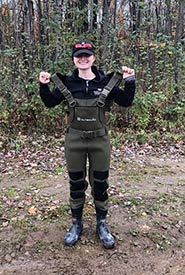
Megan Quinn wearing hip waders to stay dry while working in the Alfred Bog. (Photo by NCC)
I knew that Alfred Bog would be wet; it is a wetland after all. But I wasn’t expecting our access route to have so many water crossings. It seemed like every few hundred metres, we had to cross a stream or were stepping in puddles up to our knees. Luckily, the team wore chest waders, so soaking our boots wasn’t a problem.
3) Bring multiples
Strenuous hikes always use more resources than you think. It was important to have more water, more food and more pairs of socks than we would normally bring for a field day. There was no running back to the car if someone realized they’d left their lunch, so staying organized and having all the equipment readily available made the day run much smoother.
4) Stop to take a break (and appreciate where you are)
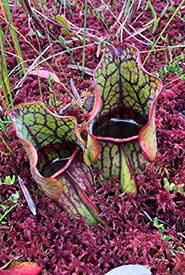
Pitcher plants are one of the unique plants you can find in the Alfred Bog (Photo by NCC)
Taking regular breaks was a necessity, but it was also an opportunity to appreciate how beautiful the Alfred Bog is. Whether it was taking the time to study moose tracks or admiring the beautiful pitcher plants poking out of the moss, these are not things we get to see every day. The Alfred Bog is a unique ecosystem, and it was such a treat for us to be able to experience it first-hand.
5) It will be harder than you think
I’ve had workouts at the gym that were easier than the hike to Alfred Bog. We did all the preparation we could, but I don’t think anyone could blame us if we were in a bad mood by the end of the day. There’s nothing more frustrating than following a moose trail, realizing it led to a dead end in the wrong direction and having to back-track through difficult terrain. Or having to stop and get your boots unstuck from the bottom of a drainage ditch.
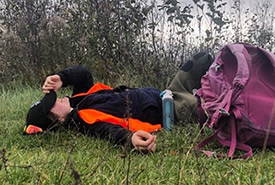
At the end of the field day, Megan Quinn had to lie down to recover. (Photo by NCC)
A good sense of humour is important for any field day, but especially the ones that require a lot of patience. I’m lucky to work with an incredible team in eastern Ontario, who kept smiling the whole day. Even so, at the end of the day, we all needed to lay down.




